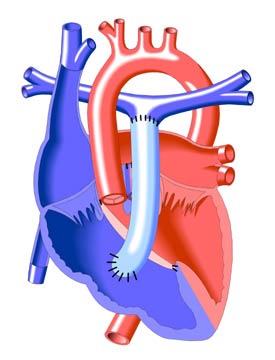| Valve and Conduit Replacements |
|
|
 |
|
Double Outlet Right Ventricle - Rastelli Operation
The Rastelli Operation is a procedure in which a valved or unvalved conduit is inserted to connect the pulmonary artery to the anatomical right ventricle (see illustration). It is used in the treatment of the single ventricle defect known as Double-Outlet Right Ventricle when D-transposition of the great arteries is present.
It is important that the Rastelli patient be monitored for the development of conduit stenosis, or narrowing, which will eventually make reoperation necessary. There are usually no obvious symptoms of this stenosis unless ventricular function becomes impaired, though there may be an increase in fatigue upon exertion and a more intense systolic ejection murmur.
When obstruction is suspected, a catheterization may be performed to determine the degree and location of the narrowing. (Echocardiography is less useful in recognizing conduit obstruction in adults than in children because of imaging problems.)
If a valved conduit is used, the patient should be monitored for the breakdown in function of the pulmonary valve, which may become regurgitant and require replacement.
The interval between conduit or valve insertion and reoperation is generally between 10 and 20 years. An unvalved conduit will usually last somewhat longer than a valved one before the stenosis becomes significant. Reoperation procedures for conduit obstructions are usually accomplished with minimal risk to the patient. |
|